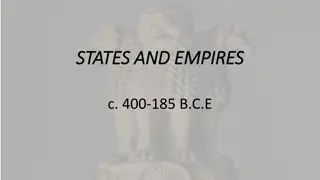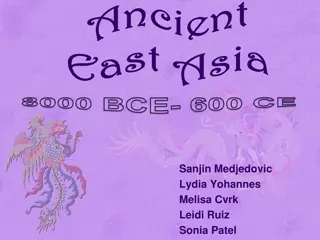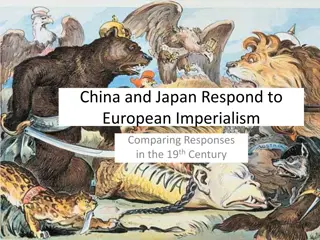Ancient China: Rise of the Qin Dynasty under Shi Huangdi's Rule
Explore the history of Ancient China as Shi Huangdi conquers warring kingdoms to unify the land. Discover how he became China's First Emperor, strengthened the empire, organized the government, and built the Great Wall for protection. Learn about the legacy and impact of the Qin Dynasty in shaping China's history.
Download Presentation

Please find below an Image/Link to download the presentation.
The content on the website is provided AS IS for your information and personal use only. It may not be sold, licensed, or shared on other websites without obtaining consent from the author.If you encounter any issues during the download, it is possible that the publisher has removed the file from their server.
You are allowed to download the files provided on this website for personal or commercial use, subject to the condition that they are used lawfully. All files are the property of their respective owners.
The content on the website is provided AS IS for your information and personal use only. It may not be sold, licensed, or shared on other websites without obtaining consent from the author.
E N D
Presentation Transcript
Lesson 3 Warring Kingdoms Unite Chapter 5 Ancient China
In 1974, farmers and archaeologists found more than 6,000 life-sized statues of soldiers and horses, along with wood and bronze chariots and metal weapons to protect Shi Huangdi s tomb. Shi Huangdi had planned to rule a second empire in the afterlife. He also made plans for a real-life empire. He believed his dynasty would last for 10,000 generations.
The Qin Dynasty The Qin Dynasty Shi Huangdi conquered seven warring kingdoms to unify China. His dynasty lasted two generations.
Chinas First Emperor China s First Emperor Shi Huangdi s original name was Zhao Zheng. He ruled the Qin (Ch in) people, which is where the name China comes from. By 221 B.C., Zheng extended his rule over most of the land and took the name Shi Huangdi (First Emperor).
Strengthening the Empire Strengthening the Empire Shi Huangdi strengthened China through strong and harsh rule to protect his empire. Shi Huangdi started the construction of the Great Wall of China as protection from nomads. Shi Huangdi connected all the different pieces of the wall with labor provided by farmers and merchants. It took hundreds of thousands of workers ten years to build the wall. Other emperors repaired and added new sections to the 4,500 mile wall.
Organizing the Government Organizing the Government Thousands of farmers were made to build roads. These roads allowed the armies to put down rebellions quickly. The emperor imprisoned or killed any opposition. Shi Huangdi divided China into districts and placed his trusted officials in control.
Reading Check Reading Check How was China s Great Wall built? For about ten years, hundreds of thousands of farmers and merchants were ordered by Shi Huangdi to connect existing defensive walls.
Unifying Economy and Culture Unifying Economy and Culture Shi Huangdi wanted to have one economy and culture.
Economic and Cultural Economic and Cultural Improvements Improvements Shi Huangdi declared one currency, common weights and measures, an improved system of writing, and a law code. The common currency made it easier to trade goods.
Restricting Freedoms Restricting Freedoms In 213 B.C. Shi Huangdi tried to control the thoughts of his people by outlawing the ideas of Confucius and other important thinkers. He required that people learn the philosophies of Qin scholars.
The Qin believed in legalism, people should be punished for bad behavior and rewarded for good behavior, and that everyone should serve the government and emperor. Shi Huangdi ordered all books except books about medicine, technology, and farming, be destroyed. The scholars that protested were killed.
The End of a Dynasty The End of a Dynasty Shi Huangdi s death in 210 B.C. was followed by four years of chaos and civil war ending with his son s death. His grandson took power but could not control China and rebellions broke out. His dynasty only lasted 15 years.
Reading Check Reading Check How did Shi Huangdi try to limit his people s freedoms? Shi Huangdi limited his people s freedoms by outlawing the ideas of Confucius and other thinkers, requiring that people learn the ideas of Qin scholars, enforcing legalism, burning many books, and having scholars who protested killed.
The Han Dynasty The Han Dynasty Liu Bang was a rebel who helped overthrow the Qin dynasty. He was the first emperor of the Han dynasty, which was stable but less harsh than Shi Huangdi s. It was the Han dynasty that educated people and based the civil service system on Confucianism. The Han dynasty lasted for about 400 years.
Wudi Wudi: The Warrior Emperor : The Warrior Emperor In 140 B.C., Liu Bang s great grandson, Wudi, came to power when he was 15 and ruled for more than 50 years. Wudi s main interests were war and military matters. Wudi means Warrior Emperor . He improved the Great Wall and strengthened the army. He increased Chinese rule, west into Central Asia, east into the Korean peninsula, and south into Vietnam.
The End of the Han Empire The End of the Han Empire Eventually, after many Han emperors, the empire began to weaken. As people in the government struggled for power the empire fell apart, including the roads and canals. Eventually warlords started to gain power. Cao Pei was one warlord who took over northern China and declared the Han dynasty over and started the Wei dynasty. The Wei dynasty ended after 50 years, breaking up into many smaller kingdoms.
Reading Check Reading Check What happened in A.D. 220? Cao Pei declared an end to the Han dynasty and set up his own Wei dynasty.
Section 3 Assessment Section 3 Assessment 1. (a) Describe What measures did Shi Huangdi take to strengthen the empire and organize the government? He built the Great Wall to defend and roads for the army to travel quickly, and divided China into districts and selected officials to govern.
1. (b) Summarize Why is Shi Huangdi a major figure in Chinese history? He was the first emperor of China and the Qin dynasty.
2. (a) Identify What measures did Shi Huangdi take to unite the economy and culture of China? He standardized currency, weights, measures, improved the system of writing, and created a law code. He also outlawed Confucianism and required everyone to study the Qin scholars.
2. (b) Analyze Information How did all of Shi Huangdi s efforts strengthen the empire? How did his leadership hurt the empire? He facilitated commerce and communication across the empire, but people ultimately rebelled, leading to chaos and civil war.
3. (a) Recall What characterized the government of China during the Han dynasty? Stability and a Confucian civil service system
3. (b) Compare and Contrast Compare the ways the emperors of the Qin dynasty and the emperors of the Han dynasty viewed the ideas of Confucius. How were their viewpoints similar or different? Qin- outlawed the ideas of Confucius, favored legalism; Han- based civil service system on Confucianism.























